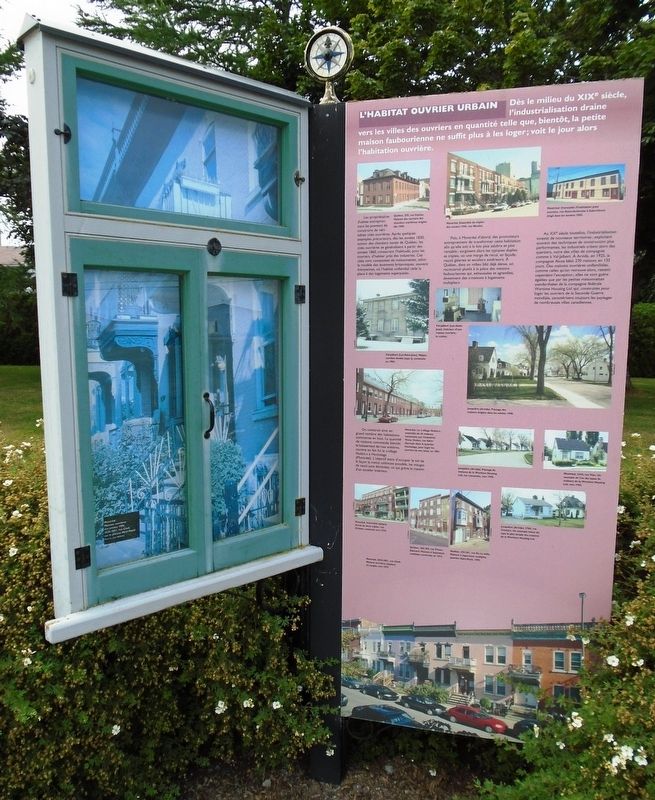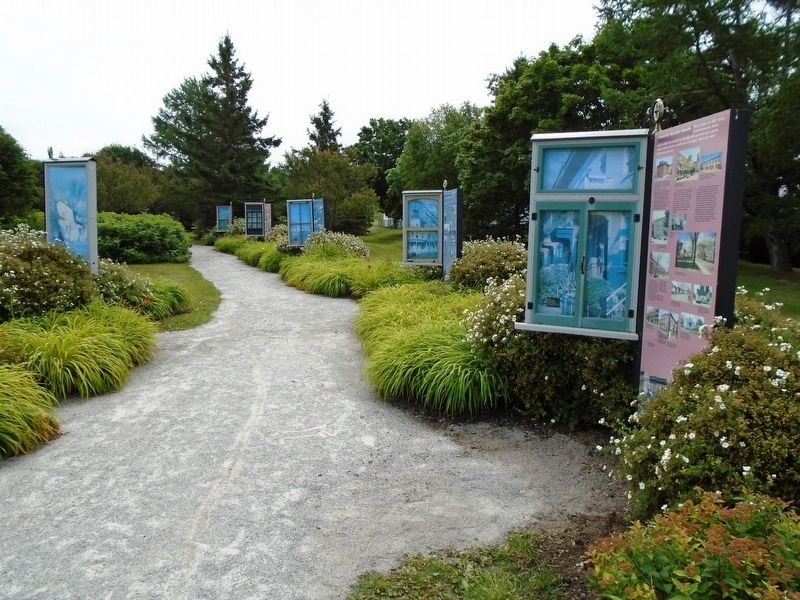L'habitat ouvrier urbain / Urban Worker Housing
Dès le milieu du XIXe siècle, l'industrialisation draine vers les villes des ourviers en quantité telle que, bientôt, la petite maison faubourienne ne suffit plus à les loger; voit le jour alors l'habitation ouvrière.
Les propriétaires d'usines entreprennent les premiers de construire de véritables cités ouvrières. Après quelques exemples précurseurs, dès les années 1830, autour des chantiers navals de Québec, les cités ouvrières se généralisent à partir des années 1860, consacrant l'habitude, pour les ouvriers, d'habiter près des industries. Ces cités sont composées de maisonnettes, selon le modèle des tenements britanniques, souvent mitoyennes, où l'habitat unifamilial cède la place à des logements superposés.
Puis, à Montréal d'abord, des promoteurs entreprennent de transformer cette habitation afin qu'elle soit à la fois plus salubre et plus rentable; surgissent alors les typiques duplex et triplex, où une marge de recul, en façade, reçoit galeries et escaliers extérieurs. À Québec, dans un milieu bâti déjà dense, on reconstruit plutôt à la pièce des maisons faubouriennes qui, exhaussées et agrandies,
deviennent des « maisons à logements multiples ».Au XXe siècle toutefois, l'industrialisation investit de nouveaux territoires; exploitant souvent des techniques de construction plus performantes, les industriels créent alors des quartiers, voire des villes de compagnie comme à Val-Jalbert. À Arvida, en 1925, la compagnie Alcoa bâtit 270 maisons en 135 jours. Des maisons ouvrières unifamiliales, comme celles qu'on retrouve alors, restent cependant l'exception; elles ne sont guère égalées que par les petites maisonnettes standardisées de la compagnie fédérale Wartime Housing Ltd qui, construites pour loger les ouvriers de la Seconde Guerre mondiale, caractérisent toujours les paysages de nombreuses villes canadiennes.
On construit ainsi en grand nombre des habitations sommaires en bois. La quantité de maisons commande bientôt le lotissement de rues entières, comme en fait foi le « village Hudon » à Hochelaga (Montréal). L'objectif étant d'occuper le sol de la façon la moins coûteuse possible, les marges de recul sont éliminées, ce qui grève la maison d'un escalier intérieur.
[Légendes photo, en haut à gauche, dans le sens des aiguilles d'une montre, lisez]
• Québec. 255, rue Daulac. Maisons des ouvriers des chantiers maritimes érigées dès 1845.
• Montréal. Ensemble de triplex des années 1930, rue Nicolet.
• Montréal. Immeuble d'habitation
• Jonquière (Arvida). Paysage des maisons érigées dans les années 1940.
• Jonquière (Arvida). Paysage des maisons de la Wartime Housing Ltd, rue Lamarche, vers 1945.
• Montréal. 2418, rue Viau. Un exemple de l'un des types de maisons de la Wartime Housing Ltd, vers 1943.
• Jonquière (Arvida). 2760, rue Couture. Un exemple intact du type le plus simple des maisons de la Wartime Housing Ltd.
• Québec. 255-261, rue De La Salle. Maisons à logements multiples, quartier Saint-Roch, 1892.
• Québec. 285-289, rue Prince-Édouard. Maisons à logements multiples construite en 1913.
• Montréal. Immeuble typique, formé de deux triplex, rue Orléans, construit vers 1910.
• Montréal. Le « village Hudon », ensemble de 46 maisons construites par l'industriel Victor Hudon, rue Saint-Germain dans le quartier Hochelaga, pour loger les ouvriers de son usine, en 1881.
• Val-Jalbert (Lac-Saint-Jean). Maison ouvrière double (type I), construite en 1904.
• Val-Jalbert (Lac-Saint-Jean). Intérieur d'une maison ouvrière: la cuisine.
[Grande légende inférieure de la photo se lit]
Montréal. 3825-3851, rue Clark. Maisons ouvrières (duplex) en rangée, vers. 1875.
[La légende de la photo d'arrière-plan de la fenêtre se lit]
Montréal
Maisons ouvrières des
[English translation]
As early as the middle of the nineteenth century, industrialization pulled workers into the cities in such numbers that soon the little suburban houses were no longer sufficient to house them; hence the birth of the worker's home.
The owners of factories were the first to build real workers' cities. After some precursory examples, as early as the 1830s around the shipyards of Quebec City, the workers' towns became widespread beginning in the 1860s, creating the custom for workers living near industries. These cities were composed of small houses, based on the British tenement model, often terraced, where single-family housing gave way to multiple-family dwellings.
Then, first in Montreal, developers undertook to transform this home so that it was both safer and more profitable. There arose the typical duplex and triplex, where a setback, in front, received galleries and outdoor stairs. In Quebec City, in an already densely-built environment, suburban houses were being rebuilt on a piecemeal basis which, raised and enlarged, became "multi-unit homes."
In the twentieth century, however, industry was investing in new territories. Often using more efficient construction techniques, industrialists then created neighborhoods or even company towns like Val-Jalbert. In Arvida, in 1925, the Alcoa company built 270 houses in 135 days. Single-family workers' houses, like those found at the time, remained the exception; they are hardly matched except by the small standardized houses of the federal Wartime Housing Ltd company, which, built to house the workers of the Second World War, still characterize the landscapes of many Canadian cities.
Wooden dwellings were built in large numbers, the quantity of houses soon ordered the subdivision of entire streets, as evidenced by the "Hudon village" in Hochelaga (Montreal). As the objective was to occupy the soil in the least expensive way possible, the setbacks were eliminated, which removed from the house an interior staircase.
• Quebec. 255 Daulac Street. Shipyard worker houses, erected as early as 1845.
[Photo captions, clockwise from top left, read]
• Montreal. 1930s Triplex set, on rue Nicolet.
• Montreal. Residential building for workers, rue Saint-Ambroise in Saint-Henri, erected in the 1850s.
• Jonquière (Arvida). Landscape of houses erected in the 1940s.
• Jonquière (Arvida). Landscape of Wartime Housing Ltd houses, rue Lamarche, circa 1945.
• Montreal. 2418 rue Viau. An example of one of the Wartime Housing Ltd home types, circa 1943.
• Jonquière (Arvida). 2760 rue Couture. An intact example of the simplest Wartime Housing Ltd house.
• Quebec. 255-261 rue De La Salle. Houses with multiple dwellings, Saint-Roch district, 1892.
• Quebec. 285-289 rue Prince Edward. Multi-family homes built in 1913.
• Montreal. Typical building, consisting of two triplexes, rue Orléans, built around 1910.
• Montreal. Rue Saint-Germain in the Hochelaga district. The "Hudon village" set of 46 houses built in 1881 by industrialist Victor Hudon to house his factory workers.
• Val-Jalbert (Lac-Saint-Jean). Double worker house (type I), built in 1904.
• Val-Jalbert (Lac-Saint-Jean). Interior of a worker's house: the kitchen.
[Large bottom photo caption reads]
Montreal. 3825-3851 rue Clark. Worker row houses (duplex), circa 1875.
[Window background photo caption reads]
Montreal
1900s worker houses, 3825-3851 rue Clark on the Mont-Royal plateau.
Topics. This historical marker is listed in these topic lists: Architecture • Industry & Commerce • Settlements & Settlers. A significant historical year for this entry is 1830.
Location. 48° 29.055′ N, 68° 29.752′ W. Marker is in Rimouski, Québec, in Rimouski-Neigette. Marker is on boulevard du Rivage (Québec Route 132), on the right when traveling north. Marker is on the grounds of Maison Lamontagne House Historic Site. Touch for map. Marker is at or near this postal address: 707 boulevard du Rivage, Rimouski QC G5L 7L3, Canada. Touch for directions.
Other nearby markers. At least 8 other markers are within walking distance of this marker. Les maisons de notables / Noteworthy Houses (here, next to this marker); Maisons des faubourgs / Suburban Houses (here, next to this marker); La maison rurale du Bas-Canada / The Rural House of Lower Canada (here, next to this marker); Villas et villégiature / Villas and Resorts (a few steps from this marker); Les maisons de colonisation / Settlement Houses (a few steps from this marker); La maison Londonienne / The London house (a few steps from this marker); La maison du commerce / The House of Commerce (a few steps from this marker); La maison urbaine en Nouvelle-France / The Urban House in New France (a few steps from this marker). Touch for a list and map of all markers in Rimouski.
Also see . . .
1. Canadian Architecture: 1867-1914. The Canadian Encyclopedia website entry (Submitted on January 21, 2019, by William Fischer, Jr. of Scranton, Pennsylvania.)
2. Maison Lamontagne House Historic Site. Historic Site website homepage (Submitted on January 21, 2019, by William Fischer, Jr. of Scranton, Pennsylvania.)
Credits. This page was last revised on June 17, 2021. It was originally submitted on January 20, 2019, by William Fischer, Jr. of Scranton, Pennsylvania. This page has been viewed 182 times since then and 19 times this year. Photos: 1, 2. submitted on January 21, 2019, by William Fischer, Jr. of Scranton, Pennsylvania.

